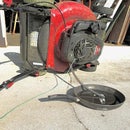Introduction: Simple Toy Tractor
This is a good project for when a grandchild begs for a toy. Hopefully, it communicates to the grandchild that toys do not need to be expensive or come from a store.
Materials
- 3/4 inch wood stock (plywood or solid wood)
- Wood dowels (3/16", 1/4", 1/2", 5/8")
- Glue
- Sandpaper
Tools
- Hole saws (1", 1 3/8", 3")
- Drill press and vise
- Bandsaw
- Sanding drum
- Fine handsaw
- Chisel
- Wood file
- Clamp or vise
Step 1: Make Wheels With a Holesaw
Rear wheels, front wheels, and a steering wheel are made with holesaws. The wheels are round and they already have a centered hole for the axle. I cut about halfway through each wheel and turned the wood over to finish the hole from the other side. That meant the wheel did not disappear into the holesaw. Removing the wheel from the holesaw was much easier because I could grasp part of the wheel by hand or with a large pliers. (See the second photo.) The rear wheels are 3/4" stock. The front wheels are 3/8" stock. The steering wheel is about 3/16" thick.
Step 2: Smooth the Rib
I used a sanding drum to smooth the rib where the cut from above met the cut from below. Do this on each wheel. Also, smooth the edges on the wheels.
Step 3: Draw and Cut the Tractor Body
Use the wheels to gauge the size relationships and make a rough drawing of the shape of the tractor body. The body on this toy tractor is 6" long and 2 3/16" high.
Step 4: Further Size Relationships
The center of the front axle is 1 1/16" below the bottom of the tractor body. The top of the axle on the rear wheels will touch the bottom of the tractor body. In this case the bottom of the tractor body is a straight line. You could make that different. In that case, a straight pencil line for reference could help locate the axles.
Step 5: Drill for the Front Wheel Post
I used the drill press and a drill press vise to drill a 1/2" hole near the front end of the tractor body. This will be for the post to which the front wheels are mounted. It is not adjustable for turning the tractor.
Step 6: Mount the Front Wheels
Cut a 1/2" dowel to length, insert it into the hole, and glue it in place.
Place the body of the tractor on the drill press table. Drill a small pilot hole through the wheel post. Drill again in steps until the hole is 1/64" or 1/32" larger than the dowel that will be the axle for the front wheels. The 1 3/8" holesaw I have uses a 3/16" inch pilot bit. Most of my holesaws use a 1/4" pilot bit. I supported the wheel post so pressure from the drill press quill does not make it deflect and give a crooked hole.
See the second photo. The wheels have been glued to a 3/16" dowel. They spin freely and no glue will seep into the axle bearing to lock the wheels when the glue has dried.
Step 7: Rear Axle Housing
I chose to make the rear axle housing from a 5/8" dowel. The chuck on my drill press is 1/2". I cannot chuck a piece of 5/8" dowel in the chuck with a 1/4" bit in a drill press vise for concentric drilling. I chose to align the dowel as best as possible and drill down the center. I drilled in steps until the axle hole was a small bit larger than the 1/4" dowel I would use for the rear axle. This insured that the wheels spin freely.
Step 8: Cut a Dado to Mount the Housing
I centered the tractor body on the axle housing and made two small cuts to mark the dado.
See the second photo. Unfortunately, the hole for the axle drifted just a little inside the 5/8" dowel. The two axles need to be parallel. I inserted a 1/4" aluminum rod in the axle hole and used a fine kerf hand saw to make kerfs next to one another. When I heard and felt the saw teeth on the aluminum rod, I knew I had cut to the correct depth. Then I removed the aluminum rod and pushed the pieces between the kerfs over to break them off. I smoothed the dado just a little with a file.
Step 9: Glue the Axle Housing in Place
I glued the axle housing to the bottom of the tractor body, checked it with a square, and clamped it until it was dry enough to handle. Then I inserted the dowel for the axle and glued the rear wheels to it as with the front axle.
Step 10: Steering Wheel
The steering wheel is an actual 7/8" in diameter. The holesaw is a 1" holesaw. It has a 1/4" pilot bit, so 1/4" dowel was needed. I drilled a 1/4" hole in steps for the steering column. My plan was simply to make it look right.
I did not do anything special for a seat on the tractor. The tractor looks fine without it, but, one could be added.
Step 11: Exhaust Pipe
I used a 1/4" dowel for an exhaust pipe that "looks right." For a little touch, I used the sanding drum to put a slope on the top of the exhaust pipe.
Sand and finish according to your preferences.











